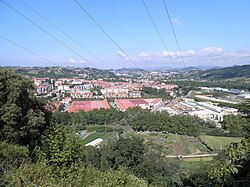Usurbil
| Usurbil | ||
|---|---|---|
| Municipality | ||
 |
||
|
||
| Location of Usurbil within the Basque Country | ||
| Coordinates: 43°16′00″N 2°03′00″W / 43.26667°N 2.05000°WCoordinates: 43°16′00″N 2°03′00″W / 43.26667°N 2.05000°W | ||
| Country | Spain | |
| Autonomous community | Basque Country | |
| Province | Gipuzkoa | |
| Comarca | Donostialdea | |
| Founded | September 11, 1371 | |
| Government | ||
| • Mayor | Xabier Arregi (Bildu) | |
| Area | ||
| • Total | 25.64 km2 (9.90 sq mi) | |
| Population (2014) | ||
| • Total | 6,168 | |
| • Density | 240/km2 (620/sq mi) | |
| Demonym(s) | Basque: usurbildarra | |
| Time zone | CET (UTC+1) | |
| • Summer (DST) | CEST (UTC+2) | |
| Postal code | 20540 | |
| Official language(s) | Basque Spanish |
|
| Website | Official website | |
Usurbil (Spanish: Usúrbil) is a town and region located in the province of Gipuzkoa in the Autonomous Community of the Basque Country, in the North of Spain.
It lies in an area well known for its sagardotegiak (cider houses) and the area adjacent to the river for its eels.
To the north Usurbil borders Donostia's Igeldo and Añorga boroughs, to the east Lasarte-Oria and Zubieta in the southeast. In the south it borders Zizurkil and to the west Aia and Orio. Donostia, the capital of the region is about 11 km away, Lasarte-Oria 2 km and Orio 10 km.
The oldest traces of human presence of the area are on the mountain called Andatza which has numerous neolithic tumuli and menhirs.
It is commonly believed that what is currently Usurbil formerly formed part of the administrative region of Hernani which extended into the area between the river Urumea and Oria.
The oldest inhabited area appears to have been on the left bank of the Urumea, broadly corresponding to the modern Urdaiaga. In a document dating back to the 13th century there is mention of a Monasterio de San Esteban which has by now disappeared but forms the foundation of the present day hermitage of San Esteban. Next to the monastery the tower-house of Urdaiaga was constructed in the 14th century which gave the area its name.
During the 12th century an important tract of land in Usurbil was donated to a monastery of Orreaga in Navarre. They remained with the monastery until they were confiscated by Mendizabal in 1836. Following their confiscation the area of Mount Irisasi and Andatza were forested and form one of the best preserved areas of forest in Gipuzkoa even today.
In 1180 King Sancho VI of Navarre added Usurbil and most of Zubieta into the boroughs of Donostia. At that time the population was living in small scattered settlements which formed the nuclei of modern-day Urdaiaga and Aginaga and the parish church was built in its present location. The most powerful family were the Atxegas who owned a tower-house next to a strategic river crossing on the Oria.
...
Wikipedia


